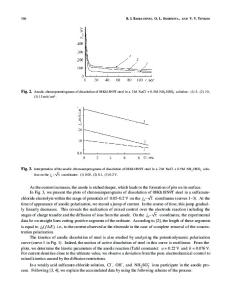Nonaqueous Viscous Electrolytes for Growth of Anodic Titania Nanotubes
- PDF / 2,528,294 Bytes
- 6 Pages / 612 x 792 pts (letter) Page_size
- 90 Downloads / 371 Views
0963-Q11-06
Nonaqueous Viscous Electrolytes for Growth of Anodic Titania Nanotubes Jan M. Macak, Sergiu P. Albu, and Patrik Schmuki Materials Science, University of Erlangen, Erlangen, 91058, Germany
ABSTRACT The present work compares two different organic electrolytes (glycerol and ethylene glycol) for the growth of self-organized TiO2 nanotubes by anodic oxidation of Ti. In both electrolytes these self-organized layers of TiO2 nanotubes can be grown to considerable thickness (several 10 µm). It is found that except for the detailed electrochemical conditions, the water content has a dramatic influence on the tube dimensions, mainly the length and the tube morphology. The best result in terms of length is achieved in “water-free” electrolytes. INTRODUCTION Anodization of titanium surfaces has been used to form titanium dioxide (Titania - TiO2), which is applicable for many industrial purposes due to its excellent corrosion resistance, chemical and mechanical stability. TiO2 is also found to be a very attractive electrode material due to its wide electrochemical potential [1, 2]. For many applications, high surface area of titania is desired that can be achieved by e.g. using anodization above a breakdown voltage in order to form porous TiO2 features on Ti and its alloy surfaces. In addition to this relatively “drastic” technique, it has been recently shown by Zwilling and coworkers [3] that self-organized and highly ordered TiO2 nanotubular layers can be grown on Ti using anodic oxidation. The only drawback of those structures was their thickness (about 500 nm) that was limited by very low pH of the electrolytes used for anodization leading to fast TiO2 dissolution [3-5]. Since then, there have been many efforts that showed [6] and explained [7] the use of inorganic pH neutral electrolytes to improve the morphology and dimensions of these structures. Organic electrolytes were explored as well [8-11] and it was shown that pure glycerol [8] and ethylene glycol [11] could be used to improve the tube length. The nanotubes have found usage in a wide variety of applications. Recently even very long tubes have been grown [12, 13]. These tubes can have length of > 250 µm and show hexagonal self-ordering [13].
In this work we compare the growth of arrays of these titania nanotubes in two organic and highly viscous electrolytes – glycerol and ethylene glycol and our target was focused towards one of the crucial factors for the tube growth - namely water content of the electrolytes. We show that the tube growth is extremely influenced by this parameter. EXPERIMENTAL DETAILS Titanium foils (99.6% purity, Advent Materials), 0.1–2 mm thick, were degreased by sonication in acetone, rinsed with deionized (DI) water, dried in nitrogen stream. Afterwadrs, they were pressed (with a Cu-plate contact) against an O-ring in an electrochemical cell (1 cm2 exposed to the electrolyte) and anodized at different potentials in glycerol and ethylene glycol electrolytes (both with water content < 0.1 vol %) containing NH4F (0. 27 M) and part
Data Loading...











